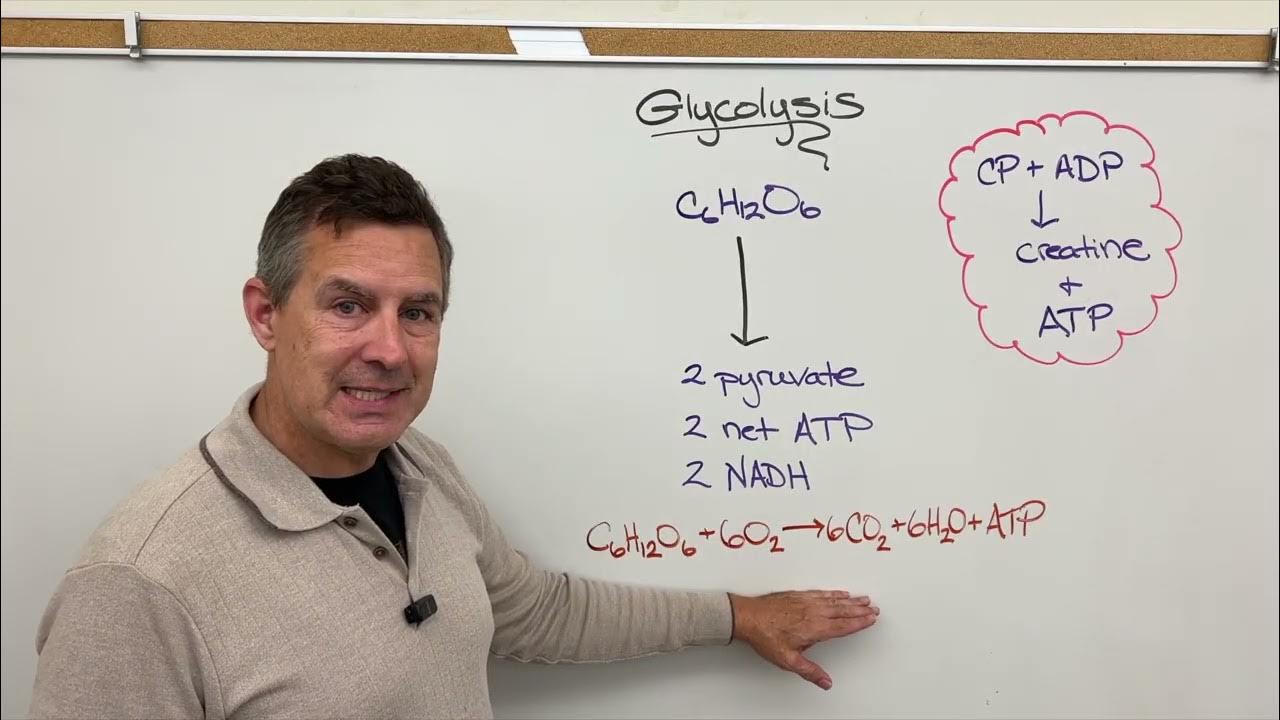Cellular Respiration Part 1: Introduction & Glycolysis
Summary
TLDRThis video is the first in a three-part series on cellular respiration, focusing on glycolysis. It encourages active learning with notes, questions, and teaching others. The video explains how cells break down glucose to produce energy in the form of ATP, starting with glycolysis in the cytoplasm. It introduces substrate-level phosphorylation and electron transport phosphorylation, describing how glucose is split into pyruvate, producing a net gain of 2 ATP. The video sets up the next stages—Krebs cycle and electron transport chain—to complete the process of generating approximately 36 ATP.
Takeaways
- 📝 Be an active learner: take notes, pause, rewatch, and explain concepts in your own words to reinforce understanding.
- 📚 The video is part of a three-part series on cellular respiration, focusing on glycolysis, the Krebs cycle, and electron transport phosphorylation.
- 🌱 Cellular respiration is the process of breaking down glucose in the presence of oxygen to produce ATP, carbon dioxide, and water.
- ⚡ Glycolysis is the first stage of cellular respiration, taking place in the cytoplasm, and does not require oxygen (anaerobic).
- 🔬 Glycolysis splits glucose into two molecules of phosphoglyceraldehyde (PGL), consuming 2 ATP in the process (energy investment phase).
- 💡 In the energy return phase, 4 ATP are produced through substrate-level phosphorylation, leading to a net gain of 2 ATP.
- 🚀 NAD+ is reduced to NADH during glycolysis, carrying high-energy electrons to the electron transport chain for later ATP production.
- 🧬 Glycolysis ends with two pyruvate molecules, which will enter the mitochondria for further processing in the Krebs cycle.
- 🔗 ATP can be produced through substrate-level phosphorylation (direct transfer of phosphate) and electron transport phosphorylation (driven by chemiosmosis).
- 🧮 In glycolysis, a net profit of 2 ATP is produced, along with 2 NADH molecules and 2 pyruvate molecules that will fuel the next stages of cellular respiration.
Q & A
What is the main focus of this video series?
-The video series focuses on cellular respiration, with part 1 discussing glycolysis, part 2 covering the Krebs cycle, and part 3 explaining electron transport phosphorylation.
What are the three stages of cellular respiration mentioned?
-The three stages are glycolysis, the Krebs cycle, and electron transport phosphorylation.
What is the primary function of cellular respiration?
-The primary function of cellular respiration is to break down glucose in the presence of oxygen to produce ATP, the cell’s energy currency, along with carbon dioxide and water as byproducts.
Where does glycolysis occur in the cell?
-Glycolysis occurs in the cytoplasm of the cell.
What is ATP, and why is it important in cellular respiration?
-ATP (adenosine triphosphate) is a molecule that stores and transfers energy within cells, and it is the main energy source produced during cellular respiration.
How many ATP molecules are produced during glycolysis, and what is the net gain?
-A total of 4 ATP molecules are produced during glycolysis, but since 2 ATP are used in the process, the net gain is 2 ATP molecules.
What happens to the NADH produced in glycolysis?
-The NADH produced in glycolysis carries high-energy electrons that are later used in the electron transport chain to generate more ATP.
What is substrate-level phosphorylation?
-Substrate-level phosphorylation is a process where a substrate directly transfers a phosphate group to ADP, forming ATP.
What is the preparatory step before the Krebs cycle, and where does it occur?
-Before the Krebs cycle, pyruvate produced from glycolysis is converted in a preparatory step that occurs inside the mitochondria.
Why is the mitochondria referred to as the cell’s power plant?
-Mitochondria are referred to as the cell’s power plant because they are the primary site of cellular respiration, where ATP is generated from glucose.
Outlines

This section is available to paid users only. Please upgrade to access this part.
Upgrade NowMindmap

This section is available to paid users only. Please upgrade to access this part.
Upgrade NowKeywords

This section is available to paid users only. Please upgrade to access this part.
Upgrade NowHighlights

This section is available to paid users only. Please upgrade to access this part.
Upgrade NowTranscripts

This section is available to paid users only. Please upgrade to access this part.
Upgrade Now5.0 / 5 (0 votes)





